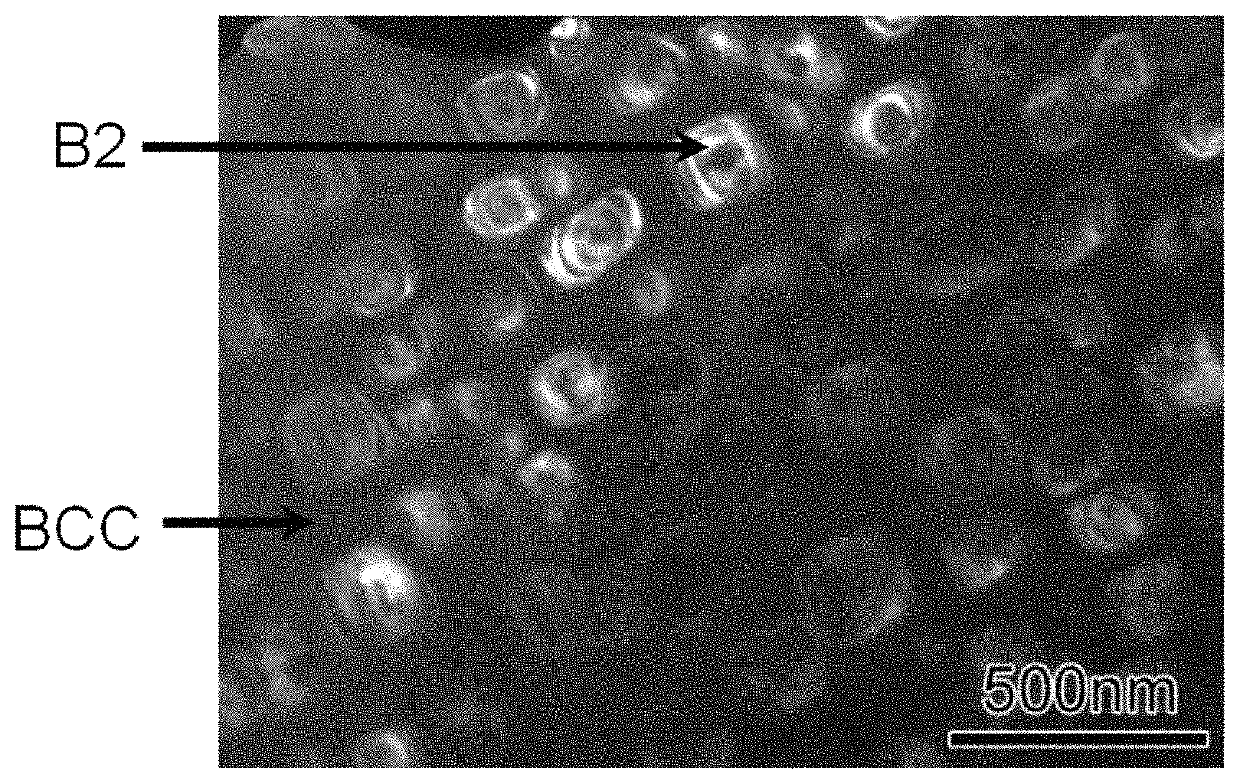Iron-based superalloy for high temperature 700 ° C. with coherent precipitation of cuboidal B2 nanoparticles
a technology of iron-based superalloys and nanoparticles, which is applied in the field of heat-resistant stainless steel, can solve the problems of serious deformation of the especially its high-temperature strength, and the tendency of semi-coherent and non-coherent precipitated second-phase particles to grow and coarse, and achieves high strength, good plasticity, and maximum high-temperature mechanical properties of the alloy.
- Summary
- Abstract
- Description
- Claims
- Application Information
AI Technical Summary
Benefits of technology
Problems solved by technology
Method used
Image
Examples
example 1 fe-10.92
Cr-13.87Ni-6.38Al-2.24Mo-0.54W-0.042Zr-0.005B (Wt. %) Alloy
[0017]Step 1: Preparation of Alloy
[0018]According to the mass percentage, the ingredients were prepared using high purity metal. The 15 g of the mixture was placed in the water-cooled copper crucible of the arc melting furnace and melted under the protection of argon atmosphere using the non-self-consuming arc melting method. And the ingots were so repeatedly melted at least five times to obtain alloy ingots of uniform composition. Then the uniformly melted alloy ingots were melted and the melt is drawn into the cylindrical copper model cavity using the copper mold suction casting process to obtain rods with a diameter of 6 mm. The alloy bars were then homogenized at 1200° C. for 2 h and finally aged at 700° C. for 24 h.
[0019]Step 2: The Microstructure and Mechanical Properties of the Alloy were Tested
[0020]OM, SEM and XRD were used to examine the Microstructure of the alloy after aged treatment, and the results showed that ...
example 2
Fe-10Cr-15Ni-6Al-3Mo-0.7W-0.03Zr-0.004B (Wt. %) Alloy
[0021]Step 1: Preparation of Alloy
[0022]According to the mass percentage, the ingredients were prepared using high purity metal. The 15 g of the mixture was placed in the water-cooled copper crucible of the arc melting furnace and melted under the protection of argon atmosphere using the non-self-consuming arc melting method. And the ingots were so repeatedly melted at least five times to obtain alloy ingots of uniform composition. Then the uniformly melted alloy ingots were melted and the melt is drawn into the cylindrical copper model cavity using the copper mold suction casting process to obtain rods with a diameter of 6 mm. The alloy bars were then homogenized at 1200° C. for 2 h and finally aged at 700° C. for 0.5 h.
[0023]Step 2: The Microstructure and Mechanical Properties of the Alloy were Tested
[0024]OM, SEM and XRD were used to examine the Microstructure of the alloy after aged treatment, and the results showed that the a...
example 3 fe-12.0
Cr-13.0Ni-7.0Al-2Mo-0.3W-0.05Zr-0.007B (wt. %) Alloy
[0025]Step 1: Preparation of Alloy
[0026]According to the mass percentage, the ingredients were prepared using high purity metal. The 15 g of the mixture was placed in the water-cooled copper crucible of the arc melting furnace and melted under the protection of argon atmosphere using the non-self-consuming arc melting method. And the ingots were so repeatedly melted at least five times to obtain alloy ingots of uniform composition. Then the uniformly melted alloy ingots were melted and the melt is drawn into the cylindrical copper model cavity using the copper mold suction casting process to obtain rods with a diameter of 6 mm. The alloy bars were then homogenized at 1200° C. for 2 h and finally aged at 700° C. for 48 h.
[0027]Step 2: The Microstructure and Mechanical Properties of the Alloy were Tested
[0028]OM, SEM and XRD were used to examine the Microstructure of the alloy after aged treatment, and the results showed that the all...
PUM
| Property | Measurement | Unit |
|---|---|---|
| diameter | aaaaa | aaaaa |
| microstructure | aaaaa | aaaaa |
| heat-resistant | aaaaa | aaaaa |
Abstract
Description
Claims
Application Information
 Login to View More
Login to View More - R&D
- Intellectual Property
- Life Sciences
- Materials
- Tech Scout
- Unparalleled Data Quality
- Higher Quality Content
- 60% Fewer Hallucinations
Browse by: Latest US Patents, China's latest patents, Technical Efficacy Thesaurus, Application Domain, Technology Topic, Popular Technical Reports.
© 2025 PatSnap. All rights reserved.Legal|Privacy policy|Modern Slavery Act Transparency Statement|Sitemap|About US| Contact US: help@patsnap.com

